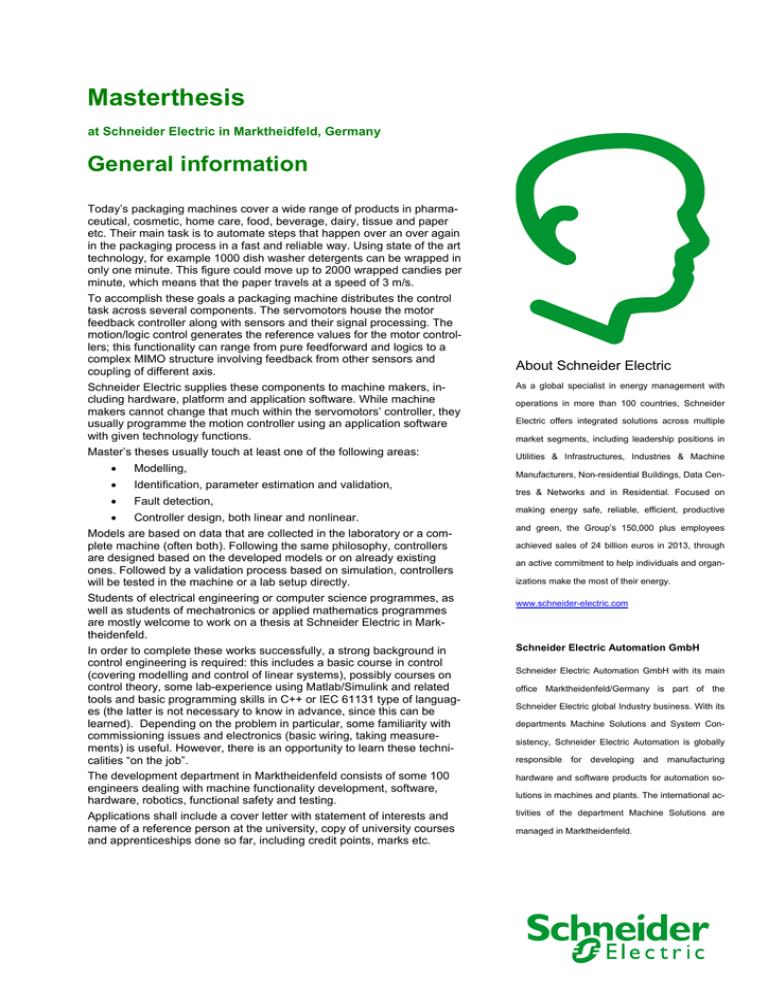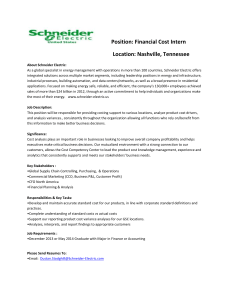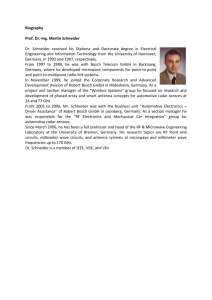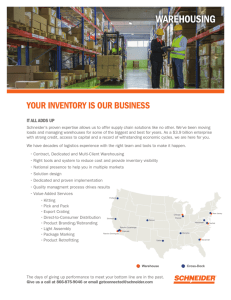Formular für Bestellungen/Anfragen
advertisement

Masterthesis at Schneider Electric in Marktheidfeld, Germany General information Today’s packaging machines cover a wide range of products in pharmaceutical, cosmetic, home care, food, beverage, dairy, tissue and paper etc. Their main task is to automate steps that happen over an over again in the packaging process in a fast and reliable way. Using state of the art technology, for example 1000 dish washer detergents can be wrapped in only one minute. This figure could move up to 2000 wrapped candies per minute, which means that the paper travels at a speed of 3 m/s. To accomplish these goals a packaging machine distributes the control task across several components. The servomotors house the motor feedback controller along with sensors and their signal processing. The motion/logic control generates the reference values for the motor controllers; this functionality can range from pure feedforward and logics to a complex MIMO structure involving feedback from other sensors and coupling of different axis. Schneider Electric supplies these components to machine makers, including hardware, platform and application software. While machine makers cannot change that much within the servomotors’ controller, they usually programme the motion controller using an application software with given technology functions. Master’s theses usually touch at least one of the following areas: • Modelling, • Identification, parameter estimation and validation, • Fault detection, • Controller design, both linear and nonlinear. Models are based on data that are collected in the laboratory or a complete machine (often both). Following the same philosophy, controllers are designed based on the developed models or on already existing ones. Followed by a validation process based on simulation, controllers will be tested in the machine or a lab setup directly. Students of electrical engineering or computer science programmes, as well as students of mechatronics or applied mathematics programmes are mostly welcome to work on a thesis at Schneider Electric in Marktheidenfeld. In order to complete these works successfully, a strong background in control engineering is required: this includes a basic course in control (covering modelling and control of linear systems), possibly courses on control theory, some lab-experience using Matlab/Simulink and related tools and basic programming skills in C++ or IEC 61131 type of languages (the latter is not necessary to know in advance, since this can be learned). Depending on the problem in particular, some familiarity with commissioning issues and electronics (basic wiring, taking measurements) is useful. However, there is an opportunity to learn these technicalities “on the job”. The development department in Marktheidenfeld consists of some 100 engineers dealing with machine functionality development, software, hardware, robotics, functional safety and testing. Applications shall include a cover letter with statement of interests and name of a reference person at the university, copy of university courses and apprenticeships done so far, including credit points, marks etc. About Schneider Electric As a global specialist in energy management with operations in more than 100 countries, Schneider Electric offers integrated solutions across multiple market segments, including leadership positions in Utilities & Infrastructures, Industries & Machine Manufacturers, Non-residential Buildings, Data Centres & Networks and in Residential. Focused on making energy safe, reliable, efficient, productive and green, the Group’s 150,000 plus employees achieved sales of 24 billion euros in 2013, through an active commitment to help individuals and organizations make the most of their energy. www.schneider-electric.com Schneider Electric Automation GmbH Schneider Electric Automation GmbH with its main office Marktheidenfeld/Germany is part of the Schneider Electric global Industry business. With its departments Machine Solutions and System Consistency, Schneider Electric Automation is globally responsible for developing and manufacturing hardware and software products for automation solutions in machines and plants. The international activities of the department Machine Solutions are managed in Marktheidenfeld. Masterthesis Designated safety functions for machinery Students of Electrical Engineering, Mechatronics, Computer Science or Mathematics What finally will create movement in a machine, is a drive and a motor. The drive houses feedback control algorithms and sensors to measure e.g. motor’s position and currents and will control the motor using a power stage. The drive will receive reference inputs from the controller, which in turn will co-ordinate all drives in the machine. Obviously, motor and drive play a very central role from the pure functional point of view: when motor or control algorithm work incorrectly, the machine will respond with a poor tracking behaviour. Reasons for an incorrectly working control algorithm may be wrong input signals, such as the motor position, provided by the sensor. When it comes to safety related applications, a motion profile that is deemed to be safe is run by the system just sketched. This is monitored by a separate safety system, which would shut down the motion system in case of unintended behaviour. This “monitoring” is called a “designated safety function” in international safety standards [1]. For example functions like “safety limited speed” are defined. This function basically compares the present speed of the drive and to a given threshold. Once exceeding this threshold, it calles a fallback state, which is very often to switch off the system. Although very simple conceptually, quite a few challenges can be observed, especially in the context of robustness: not to raise false alarms when being “a little bit” above threshold and/or only for short time; accuracy of signal vs. accuracy of threshold; transient behaviour between detection and switch off; quality of diagnostics at low speeds. The task would be to model and implement a selection of the designated functions as listed in [1], followed by assessment of accuracy and robustness on a testbench. About Schneider Electric As a global specialist in energy management with operations in more than 100 countries, Schneider Electric offers integrated solutions across multiple market segments, including leadership positions in Utilities & Infrastructures, Industries & Machine Manufacturers, Non-residential Buildings, Data Centres & Networks and in Residential. Focused on making energy safe, reliable, efficient, productive and green, the Group’s 150,000 plus employees achieved sales of 24 billion euros in 2013, through an active commitment to help individuals and organizations make the most of their energy. www.schneider-electric.com The work will obviously need a lot of data collection both on the test bench and possibly in real machines. After having built the algorithms it is necessary to validate the structure, the parameters and the associated uncertainies by measurement data. Schneider Electric Automation GmbH Schneider Electric Automation GmbH with its main Area/Background Modeling, Parameter estimation/Identification, Fault detection, Programming (Matlab, Simulink), Experiments at testbench. office Marktheidenfeld/Germany is part of the Schneider Electric global Industry business. With its Interested? We are looking forward to receiving your application: Dr. Wolfgang Reinelt, Schneider Electric Automation GmbH Schneiderplatz 1, 97828 Marktheidenfeld, Germany wolfgang.reinelt@schneider-electric.com References [1] IEC 61800-5-2. Adjustable speed electrical power drive systems – Part 5-2: Safety requirements –Functional. First edition 2007-07. departments Machine Solutions and System Consistency, Schneider Electric Automation is globally responsible for developing and manufacturing hardware and software products for automation solutions in machines and plants. The international activities of the department Machine Solutions are managed in Marktheidenfeld.





